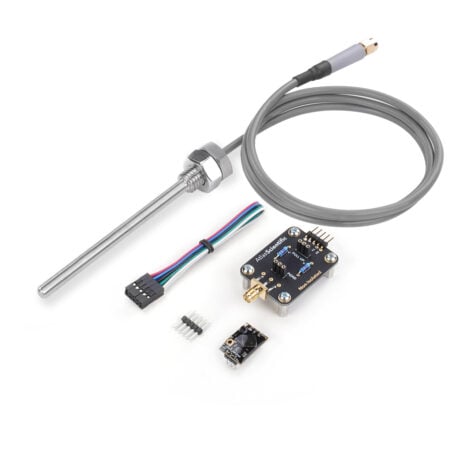As temperature levels increase, the amount of dissolved oxygen in water decreases due to the inverse relationship between dissolved oxygen and temperature.
Dissolved oxygen (DO) describes how much oxygen (O2) is dissolved in water, and therefore available to aquatic organisms. The amount of DO in water bodies also tells us a lot about the water quality in wastewater and drinking industries.
Temperature is not only important as it indicates how much oxygen the water can hold, but it also has a direct influence on biochemical reactions within the water’s sediment. Increases in the water’s temperature are also linked to increased metabolic rates, which affect the biochemical oxygen decay and increase nitrification, photosynthesis, and respiration.
Where Does Dissolved Oxygen Come From?
Dissolved oxygen originates from the surrounding air or as a plant byproduct of photosynthesis.
The Earth’s surrounding air consists of 21% O2, which slowly diffuses across the water’s surface or enters via aeration. This process can occur naturally (wind) or human-induced (waterwheels, pumps, and dams).
Photosynthesis from phytoplankton, algae, and other aquatic plants can also produce dissolved oxygen. Dissolved oxygen is then depleted via chemical oxidation and respiration by aquatic organisms and the decomposition of organic materials present in the water.
Does Temperature Affect Dissolved Oxygen?
Many factors affect DO levels in the water, but changes in the temperature of the water are the most common.
Temperature affects dissolved oxygen because they have an inverse relationship; as temperature increases in water, DO levels decrease.
When water temperatures increase, it causes the gas and water molecules to gain more energy which in turn breaks the weak molecular interactions between water and oxygen molecules, causing the oxygen to escape. Also, as water temperatures increase, the solubility of oxygen decreases, increasing water pollution and negatively affecting aquatic habits and organisms.
Water temperatures usually increase during the summer months and during the day, when more sunlight penetrates the water’s surface. However, despite temperature increases leading to declined DO levels, as aquatic photosynthesis is light-dependent, the DO levels in the water usually peak during the daytime and decline during the night.
Yet, if DO levels reach extremely low levels (<3 mg/L), the water conditions become hypoxic, which quickly becomes lethal to aquatic plants and animals.
Low levels of DO from increased water temperatures also affect the solubility and availability of essential nutrients. When nutrients are released from the sediment, it can cause fluctuations in the pH of the water and allow excess algae growth from elevated levels of phosphorus and nitrogen.
Consequences Of Low Dissolved Oxygen Levels In Water
Dissolved oxygen is one of the most significant indicators of water quality in water treatment systems and aquariums. Water that has a DO concentration above 6.5-8 mg/L and between 80-120% is considered healthy.
Consequences For Aquatic Life
Despite different organisms having a particular tolerance range, DO levels lower than 3 mg/L are a cause for concern, and levels below 1 mg/L are considered hypoxic.
Hypoxic water kills fish, depleting valuable fisheries and disrupting aquatic ecosystems. Aquatic animals that are mobile can usually survive hypoxic waters by moving to areas rich in oxygen, however, in closed systems like aquariums and ponds, the fish are unable to escape from the low DO levels, and therefore they die.
Low DO levels additionally affect the life stages of fish embryos. This includes the number of eggs that hatch, the larval development of fish, and fish populations.
Consequences For Water Treatment systems
In wastewater treatments, low DO concentrations below 1 mg/L allow filamentous growth to take over, killing aerobic and nitrifying microbes. Yet, if DO levels are too high it encourages settling, negatively affecting the water quality.
In drinking water systems, low DO levels allow minerals to dissolve into the water, affecting the water quality. Despite higher DO levels improving the taste of drinking water, elevated oxygen levels often increase corrosion in water pipes, therefore, public water systems aim to use water with the least amount of DO without it affecting the water quality.
Measuring Temperature & Dissolved Oxygen In Water
Temperature and DO are the main indicators of water quality, therefore it is important to closely monitor levels in different applications.
Dissolved oxygen probes measure the amount of oxygen that diffuses across a permeable (or semi-permeable) membrane into a probe (sensor). As dissolved oxygen has an inverse relationship to temperature, probes must be calibrated before each use.
You should also closely monitor the temperature of the water. Temperature sensors are recommended to accurately measure temperature levels in the water. Temperature sensors work by providing readings via electrical signals.
How To Increase Dissolved Oxygen Levels?
If your DO levels are too low, you can simply aerate the water in the following ways:
- Run a portable splash or spray aerator into the water. This method is commonly used in ponds up to 20 acres.
- For more constant DO levels, IFAS recommends running a fixed diffuser system, airlift pump, fan, or a paddle wheel to increase water movement across the water’s surface.
- For aquariums, an air stone or air pump can easily be installed. These create water turbulence, increasing gas exchange between the air and water molecules.
- Adding rooted aquatic plants to promote photosynthesis will also increase the amount of oxygen in the water.
- Lastly, exposing the water system to pure oxygen gas will increase DO levels. However, when using this method, it is important to avoid supersaturation, as this can lead to fish and plant death.
So, what happens if you have exceeded the dissolved oxygen concentration?
If you have added too much oxygen into the water, there are five common ways to remove dissolved oxygen from water:
- Thermal degassing
- Vacuum degassing
- Countercurrent exchange
- Nitrogen purging/stripping
- Using nutrients and plants
Summary
As temperature levels increase, the amount of dissolved oxygen in water decreases due to the inverse relationship between the two.
Dissolved oxygen is essential for aquatic habitats and for improving water quality in wastewater and drinking water systems. When DO levels drop below 3 mg/L, it can have detrimental effects, therefore frequently testing DO levels is required in a wide range of industries and applications.
If you have any questions regarding temperature or dissolved oxygen, or what testing kit will best suit your application needs, do not hesitate to contact our world-class team at Atlas Scientific.
Dissolved Oxygen Probes & Sensors
Temperature Probes & Sensors

















